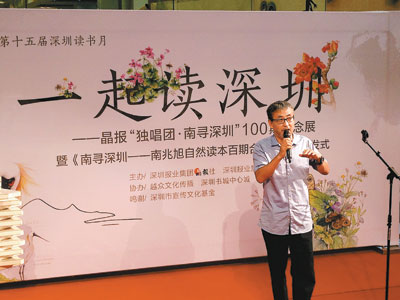
Anna Zhao
anna.whizh@yahoo.com
A BOOK delineating Shenzhen’s natural residents — plants, birds, insects, wild animals and marine life — was published Friday as a landmark publication to draw awareness to the city’s biodiversity and the plight of local wildlife.
The book “Nan’s Exposure Shenzhen” is a collection of 100 articles on the city’s natural creatures from the weekly column “Nan’s Exposure Shenzhen” (南寻深圳) published on the Daily Sunshine since Nov. 5, 2012. A homonymic exhibition commemorating the articles is also being held on the second floor of Shenzhen Book City CBD Store in Futian District till Dec. 10, before it goes on tour to Hong Kong, Macao and Taipei.
Nan Zhaoxu, author of the book and contributor to the column, recorded the beauty of Shenzhen’s wildlife during all four seasons and the unique plants and animals that touched him and his hiking companions during their trips into the wild, most of which the city’s urban residents are oblivious to.
With cameras in hands, Nan and his friends captured the lives of various plants and animal species during their numerous visits to seldom beaten tracks of Wutong Mountain, Qiniang Mountain, Neilingding Island, Baguang Village and some nameless mountains during the past 16 years.
“Shenzhen is a place full of concrete blocks where people make money in hasty steps. You will never know the beauty of its nature unless you step into the wilderness — the water and valleys of its mountains, the twittering birds and crawling beetles — it is all amazingly beautiful,” said Nan, the CEO of Yuezhong Cultural Transmission Co.
Hu Hongxia, editor-in-chief of the Daily Sunshine and curator of the exhibition, said the significance of the book lies in that it offers a chance for Shenzhen residents to recognize the city as their homeland, rather than a mere residence.
“We migrate to live in Shenzhen but have no knowledge about its natural environment. We can’t really call the place our home if we can’t name the trees and flowers around us. We’re living here with family and friends, but we tend to forget that plants and animals are also with us. In this respect, the book not only presents the city’s beauty in nature, but, more importantly, it teaches us to know the companions we’re living with in the natural world,” Hu said.
Since the birth of the newspaper column, the articles have been well received, not only for the beautiful pictures of rare plants and animal species it showcases, but also for Nan’s explanations about their existence with passionate language and humanistic care.
Hu said that it’s very rewarding to write the articles because many readers regarded the pages as good science reading material, so they often read the articles together with their children.
“Many people read the paper with excitement and surprise, exclaiming what a beautiful place Shenzhen is — that’s an encouraging feedback,” Hu said. “The wildlife mentioned in the book is nature’s heritage bestowed on us, and we should embrace it, love it and protect it.”
Pan Wenshi, a life science professor at Peking University and who has spent 35 years working and living in the wilderness, praised the book as a great contribution to the city for raising people’s awareness about how humans and natural creatures should coexist.
“Shenzhen is home not only to millions of people but also to various big and small animals that deserve equal rights of existence. We should coexist with them and set a good example for the rest of the world,” Pan said.
|

